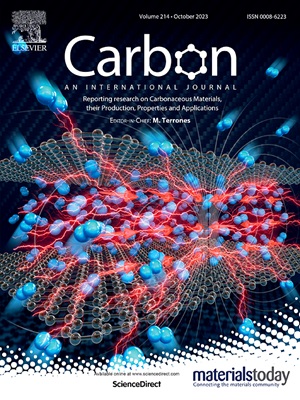Macroscopic tribological properties and molecular simulation study of carbon quantum dots modified by ionic liquids
IF 10.5
2区 材料科学
Q1 CHEMISTRY, PHYSICAL
引用次数: 0
Abstract
Using amino acid ionic liquids (Ser–TEA) as surface modifiers and citric acid (CA) the carbon source, ionised carbon quantum dots (Ser–CA/CQDs) of uniform size were successfully prepared in this study. They exhibited excellent dispersion stability and tribological performance in an ethylene glycol aqueous solution (EGaq), as revealed using a one-step pyrolysis method. Macroscopic experimental results show that adding 2.0 wt % Ser–CA/CQDs reduces the friction coefficient of EGaq from 0.16 to 0.128, and the wear scar volume decreases by 51.97 %, which is attributed to the formation of a hydration layer and tribofilm. Furthermore, molecular dynamics simulations at the microscopic level revealed that the weak interaction energy between Ser–CA/CQDs and the friction pair surface, combined with the "ball-bearing effect", significantly reduced frictional resistance. Further, the lubrication performance of EGaq improved with the formation of a carbon film and an interface with low shear strength. This process offers a novel atomic-level perspective for understanding and optimising the applications of nanolubricant additives.

求助全文
约1分钟内获得全文
求助全文
来源期刊

Carbon
工程技术-材料科学:综合
CiteScore
20.80
自引率
7.30%
发文量
0
审稿时长
23 days
期刊介绍:
The journal Carbon is an international multidisciplinary forum for communicating scientific advances in the field of carbon materials. It reports new findings related to the formation, structure, properties, behaviors, and technological applications of carbons. Carbons are a broad class of ordered or disordered solid phases composed primarily of elemental carbon, including but not limited to carbon black, carbon fibers and filaments, carbon nanotubes, diamond and diamond-like carbon, fullerenes, glassy carbon, graphite, graphene, graphene-oxide, porous carbons, pyrolytic carbon, and other sp2 and non-sp2 hybridized carbon systems. Carbon is the companion title to the open access journal Carbon Trends. Relevant application areas for carbon materials include biology and medicine, catalysis, electronic, optoelectronic, spintronic, high-frequency, and photonic devices, energy storage and conversion systems, environmental applications and water treatment, smart materials and systems, and structural and thermal applications.
 求助内容:
求助内容: 应助结果提醒方式:
应助结果提醒方式:


